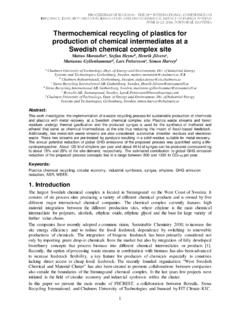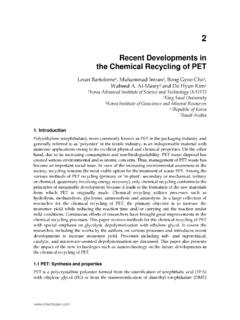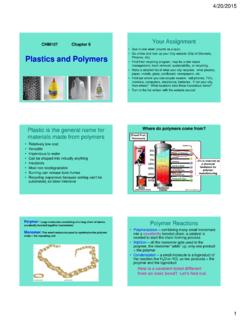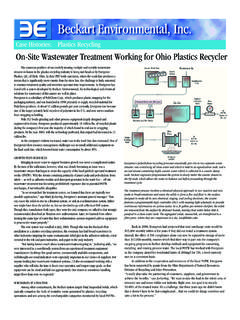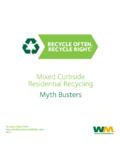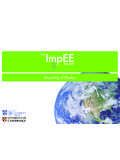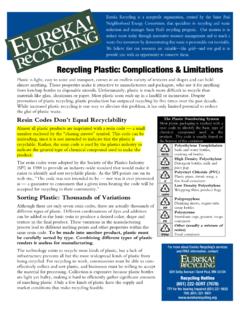Transcription of Chemical Recycling of Plastics Waste (PVC and other resins)
1 712 UHSRUWSTB-99-55 FinalSchoemakerstraat Box 60302600 JA DelftThe NetherlandsPhone +31 15 269 69 00 Fax +31 15 269 54 60 All rights part of this publication may beReproduced and/or published by printPhotoprint, microfilm or any other meansWithout the previous written consent case this report was drafted onInstructions, the rights and obligations ofContracting parties are subject to either theStandard Conditions for ResearchInstructions given to TNO, or the relevantAgreement concluded between theContracting partiesSubmitting the report for inspection toParties who have a direct interest ispermitted. 1999 TNOTNO Institute of Strategy,Technology and Policy&KHPLFDO 5HF\FOLQJ RI 3 ODVWLFV :DVWH 39& DQG RWKHU UHVLQV DateDecember 1999 Author(s)Dr.
2 A. Tukker (TNO-STB)Ing. H. de Groot (TNO Industrial Research)Ir. L. Simons (TNO-STB)Ir. S. Wiegersma (TNO Industrial Research)AssignorEuropean Commission, DG IIIC ontact: Mrs. M-C. Le PicardNetherlands organization forApplied scientific research (TNO)The Standard Conditions for Research InstructionsGiven to TNO, as filed at the Registry of the DistrictCourt and the Chamber of Commerce in The HagueShall apply to all instructions given to ,1752'8&7,21 7(&+12/2*,(6 )25 39& $1' 3/$67,&6 :$67( 0$1$*(0(17 Chemical Recycling OF MIXED PLASTIC 8 ,QWURGXFWLRQ 7H[DFR JDVLILFDWLRQ SURFHVV 7KH 3RO\PHU &UDFNLQJ 3 URFHVV FRQVRUWLXP SURMHFW 7KH %$6) &RQYHUVLRQ 3 URFHVV 8VH RI 0L[HG 3 ODVWLF :DVWH LQ %ODVW )XUQDFHV 9 HED &RPEL &UDFNLQJ 3 URFHVV 69= JDVLILFDWLRQ SURFHVV Chemical Recycling OF PVC-RICH 24 ,QWURGXFWLRQ %6/ ,QFLQHUDWLRQ SURFHVV $N]R 1 REHO 6 WHDP *DVLILFDWLRQ 3 URFHVV /LQGH *DVLILFDWLRQ 3 URFHVV 3\URO\VLV SURFHVV ALTERNATIVES TO Chemical 34 ,QWURGXFWLRQ 7KH 9LQ\ORRS 39& UHFRYHU\ SURFHVV &HPHQW NLOQV HQHUJ\ UHFRYHU\ 0 XQLFLSDO VROLG ZDVWH LQFLQHUDWRUV ZLWK HQHUJ\ UHFRYHU\ 2 WKHU WUHDWPHQW REVIEW OF TECHNICAL AND ECONOMIC 40 3266,%/( &2//(&7,21 6758&785(6 ,1 7+( 39& :$67( &+$,1 AN OVERVIEW OF THE PVC Waste MANAGEMENT MODEL 1: BRING SYSTEM FOR MIXED PLASTIC MODEL 2: SEPARATION OF MPW FROM INTEGRAL MODEL 3.)))))))]
3 BRING SYSTEM FOR SPECIFIC PVC MODEL 4: SEPARATION OF PVC OR MPW FROM COMPLEX PRODUCT 52 (19,5210(17$/ &203$5,621 COMPARISON OF OPTIONS FOR MPW .. 54 ,QWURGXFWLRQ 'LVFXVVLRQ E\ HQYLURQPHQWDO WKHPH &RQFOXVLRQV TECHNOLOGIES FOR PVC-RICH 58 TNOC hemical Recycling of Plastics Waste (PVC and other resins) STB 99-55 Final2 ,QWURGXFWLRQ 'LVFXVVLRQ SHU WKHPH &RQFOXVLRQ OVERALL 59 :$67( 6833/< 6&(1$5,26 GENERIC 60 ,QWURGXFWLRQ 6 LWXDWLRQ LQ WKH EDVH \HDU 6 LWXDWLRQ LQ DQG *HQHUDO DVVXPSWLRQV YDOLG IRU HDFK ZDVWH VWUHDP AGRICULTURAL 66 &XUUHQW VLWXDWLRQ )XWXUH VLWXDWLRQ $YDLODELOLW\ RI ZDVWH IRU QRQ PHFKDQLFDO UHF\FOLQJ BUILDING 67 &XUUHQW VLWXDWLRQ )XWXUH VLWXDWLRQ $YDLODELOLW\ RI ZDVWH IRU QRQ PHFKDQLFDO UHF\FOLQJ HOUSEHOLD Waste (NON PACKAGING).))
4 70 &XUUHQW VLWXDWLRQ )XWXUH VLWXDWLRQ $YDLODELOLW\ RI ZDVWH IRU QRQ PHFKDQLFDO UHF\FOLQJ PACKAGING Waste (HOUSEHOLD AND DISTRIBUTION).. 71 &XUUHQW VLWXDWLRQ )XWXUH VLWXDWLRQ $YDLODELOLW\ RI ZDVWH IRU QRQ PHFKDQLFDO UHF\FOLQJ 73 &XUUHQW VLWXDWLRQ )XWXUH VLWXDWLRQ $YDLODELOLW\ RI ZDVWH IRU QRQ PHFKDQLFDO UHF\FOLQJ 74 &XUUHQW VLWXDWLRQ )XWXUH VLWXDWLRQ $YDLODELOLW\ RI ZDVWH IRU QRQ PHFKDQLFDO UHF\FOLQJ ELECTRICAL AND ELECTRONIC 77 &XUUHQW VLWXDWLRQ )XWXUH VLWXDWLRQ $YDLODELOLW\ RI ZDVWH IRU QRQ PHFKDQLFDO UHF\FOLQJ 79 6800$5< $1' &21&/86,216 CURRENT 82 TNOC hemical Recycling of Plastics Waste (PVC and other resins) STB 99-55 COLLECTION STRUCTURES AND ENVIRONMENTAL Waste SUPPLY 85 ,QWURGXFWLRQ 3 ODVWLF ZDVWH ZLWK D ORZ 39& FRQWHQW 39& ULFK ZDVWH OVERALL 88/,7(5$785( $33(1',; $ :$67( 6833/< 6&(1$5,26 )25 3/$67,&6 :$67( $33(1',; % :$67( 6833/< 6&(1$5,26 )25 39& :$67( $33(1',; & /,67 2) 25*$1,6$7,216 &217$&7(' $33(1',; ' *5266 /,67 2) ,1,7,$7,9(6 )25 )(('672&.)))))
5 5(&<&/,1* TNOC hemical Recycling of Plastics Waste (PVC and other resins) STB 99-55 Final4 ,QWURGXFWLRQFor several years, debate has raged about the plastic PVC. Industry andenvironmentalists contend with each other virtually around the world. Theenvironmentalists pursue a ban, industry aims to improve its environmentalperformance and believes that from an overall viewpoint there is no reason forsuch far-reaching measures against their material. In this context, the material popsup on the political agenda on a regular basis in a number of EU member that are often the subject of debate include emissions from EDC/VCM/PVCproduction, the use of certain stabilisers and plasticisers (such as phthalates), andPVC Waste management.)
6 Such debates have led in several EU member states to(in)formal measures against PVC. Such measures on the national level can lead tobarriers to trade. As a result, an EU policy on such PVC-related issues is policy at EU level prevents that differences in national policies hamper a properfunctioning of the internal market, and can ensure an equal, appropriate level ofenvironmental protection in member this context, the Commission aims to define a policy with regard to the subjectof end-of-life PVC products. For this purpose, DG III and DG XI havecommissioned various studies focussing on several aspects of PVC wastemanagement. This concerns studies into:1. Specific costs of incineration of PVC in municipal solid Waste incinerators(MSWIs), which is being performed by Bertin, France;2.
7 Costs and benefits of diverting PVC from incineration, which is beingperformed by AEA, UK;3. Landfill of PVC Waste , which is being performed by a consortium led byArgus, Germany;4. Mechanical Recycling of PVC Waste , which is being performed by aconsortium lead by Prognos, Switzerland;5. Chemical Recycling of PVC .The last study, on Chemical Recycling of PVC, is being carried out by TNO withDG III as the primary client. The overall aim of the project is to analyse the rolethat Chemical Recycling may have in a future European system for PVC wastemanagement. Since both rather pure PVC Waste and mixed plastic Waste (MPW)containing PVC may in principle be treated by Chemical Recycling , this studycannot concentrate on PVC alone.
8 Chemical Recycling of PVC will therefore betreated within the broader context of Chemical Recycling of plastic Waste . Morespecifically, the Terms of Reference (ToR) for the project asked us to address thefollowing elements: The term feedstock Recycling may be more often used than Chemical Recycling . Since the Termsof Reference for this study used the latter term, we will speak of Chemical Recycling in this Recycling of Plastics Waste (PVC and other resins) STB 99-55 Final51. making an inventory of all current research programmes, pilot projects andcommercial plants involved in the Chemical Recycling of Plastics ;2. evaluating the technical issues related to the Chemical Recycling of Plastics ;3.
9 Evaluating the possible future scenarios in the field of Chemical Recycling ,including a forecast of probable industrial investments (member state bymember state);4. describing the effects on the environment and the risks, analysing costs andbenefits, and making a comparative assessment of the environmental,economical and technical aspects of the various technologies for chemicalrecycling, mechanical Recycling , and incineration with energy recovery for PVCand mixed Plastics containing specific approach of how we dealt with these elements is discussed in thespecific chapters related to these tasks. In general, the inventory of researchprogrammes was based on a literature review and expert inquiry. For the mostfeasible Chemical Recycling options, an in-depth inquiry of the consortium backingsuch initiatives was performed.
10 As for the scenarios, for PVC Waste arising wecould rely on the extensive modelling work performed by the European union ofPlastics Converters (EuPC). On the basis of historical PVC consumption dataand product-life times, theoretical PVC- Waste arising was calculated and checkedagainst practical data. This work has resulted in the most comprehensive andreliable estimates of PVC Waste data available at EU level to date. In order toensure a comparable basis of the projects, it is most likely that their data will beused as well in the studies of Prognos (mechanical Recycling ) and AEA(incineration). These parallel studies would result in dedicated information onmechanical Recycling and incineration (with or without energy recovery).










